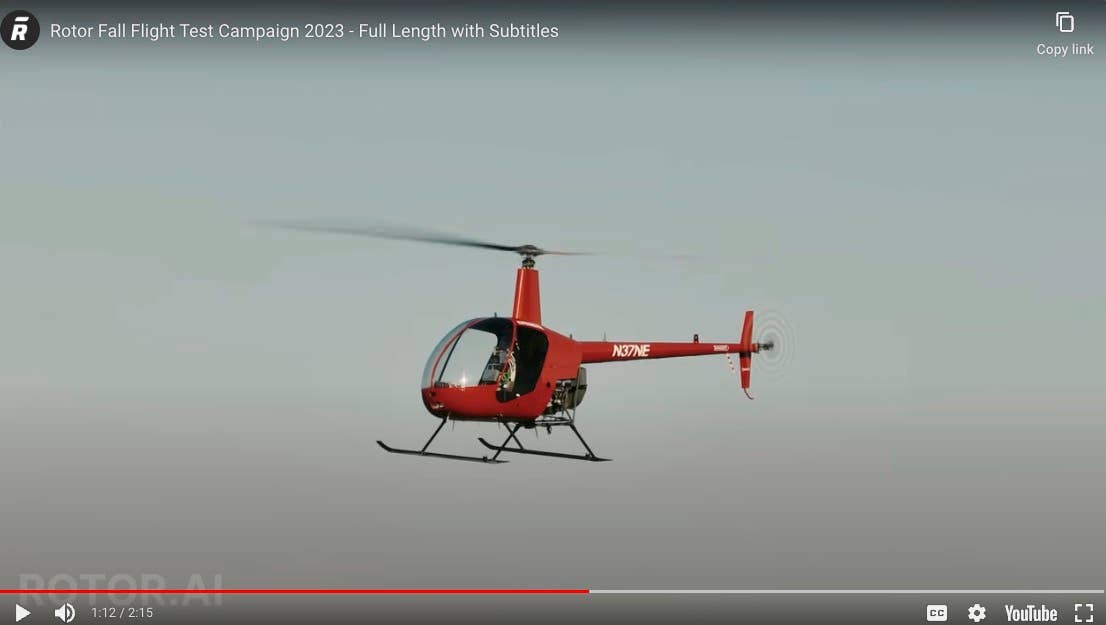NH Company Completes Autonomous Helicopter Flight Test Program
Nashua, New Hampshire-based Rotor Technologies announced yesterday (Nov. 7) it has completed a test campaign for its uncrewed R220Y, a derivative of the Robinson R22 piston-powered helicopter. Rotor, which self-describes…

Screenshot from Rotor Technologies’ video of its autonomous flight-test program. A link to the video is included in the text of the article.
Nashua, New Hampshire-based Rotor Technologies announced yesterday (Nov. 7) it has completed a test campaign for its uncrewed R220Y, a derivative of the Robinson R22 piston-powered helicopter. Rotor, which self-describes as a developer of autonomous vertical takeoff and landing (VTOL) aircraft, claims theirs is the first-ever test program involving an uncrewed full-scale civilian helicopter. A video on the campaign is posted on the company website.
The flight test regime involved two examples of the R220Y autonomous helicopter. Modifications from the stock R22 include removing seats, pilot controls and instrument panels. All flight functions of the test helicopters were automated by Rotor’s technology, according to the announcement. The test regime included more than 20 hours of flight time and more than 80 hours of engine-run time.
According to the Rotor statement, “These flights successfully proved Rotor’s flight control systems, autonomous hover and velocity modes, and vision-based perception systems. The campaign also developed the aircraft’s long-distance flight capability through in-flight testing of long-range radio equipment and cellular LTE communication links—although all flights were conducted over a limited radius within direct line of sight of a ground control station.”
Rotor Founder and CEO Dr. Hector Xu said, “Our [artificial intelligence—AI] pilot system is already expert-level at tasks like precision flight control and navigation in poor visibility conditions, and we’re increasing its capabilities every day.” Robinson Helicopter is fully on board with the program. The California-based manufacturer’s VP of operations, David Smith, said, “We believe that our flight heritage and manufacturing capability will position Robinson to be a key player in the next generation of VTOL aviation.”
Rotor’s “next step” is developing its R550X, a similarly modified version of Robinson’s four-seat R44 Raven II. Rotor chief commercial officer Ben Frank said, “We’re taking all the technology that we’ve developed on the R220Y and are putting it on a similar—and even more capable—platform. We’re working with a set of close partners to put the R550X into revenue operation in 2024.”
The R550X is expected to have a payload capacity of 1,212 pounds and more than three hours’ endurance. Potential mission types for the autonomous helicopter include examples of the classic “three Ds” often targeted by developers of uncrewed aircraft—Dirty, Dangerous and Dull. They include firefighting, crop dusting, construction, humanitarian aid and remote cargo delivery.
Peering even further into the future, Rotor anticipates an eventual move into passenger operations for its autonomous aircraft. The company notes that a 200-mile, traffic-snarled journey (such as Boston to New York) could be accomplished in 90 minutes with its aircraft.
Rotor did not immediately return email and telephone requests from AVweb for further details on pricing, financing and production planning.






